db Eats: Jin Sha at Four Seasons Hotel Hangzhou at West Lake
By Douglas BlydeDouglas Blyde continues his travels around China with a visit to the Four Seasons Hotel Hangzhou at West Lake. Head sommelier Olive Gao guides him through a list covering everything from lard-washed rice wine to tea.
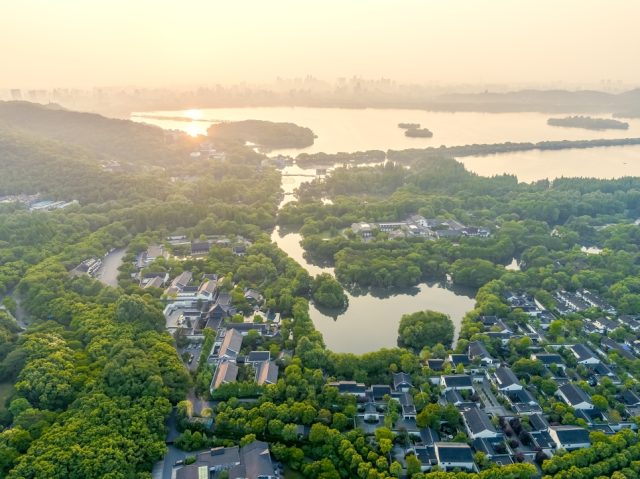
With “lush, peaceful greenery”, observed Forbes, the only international luxury hotel built on the UNESCO-registered West Lake “couldn’t feel more different from the big city” of Hangzhou in the misty distance. The low, long, spacious resort features 81 rooms amidst bamboo forests and a lagoon. The Michelin Guide praised chef Joe Wang’s “Zhejiang neo-classics with modern twists” which draw on “seasonal ingredients sourced from all over China.” And of head sommelier, Olive Gao’s liquid assets, an “array of teas and wines” is supplemented by the meaningful “range of Huangjiu on offer.”
Design
Perhaps incongruously twinned with Leeds some 5,600 miles west, Hangzhou has been celebrated by historical poets such as Bai Juyi and Su Dongpo, with the latter praising “the gleam of this bright expanse of water.” Fringed by tea plantations, its oval, peach and willow-fringed West Lake features a fourth-century temple, an 80-foot-high Buddha, and a bulky, modern city with a decent revolving buffet restaurant. This metropolis has emerged a tech capital since Alibaba was founded here by former English teacher, Jack Ma in 1999. With proximity to Shanghai via high-speed trains with low-tech toilets, the population swelled to 8.5 million this year, including the world’s twelfth-largest concentration of billionaires. In fact, the city’s economic output overshadows that of the entirety of Sweden.
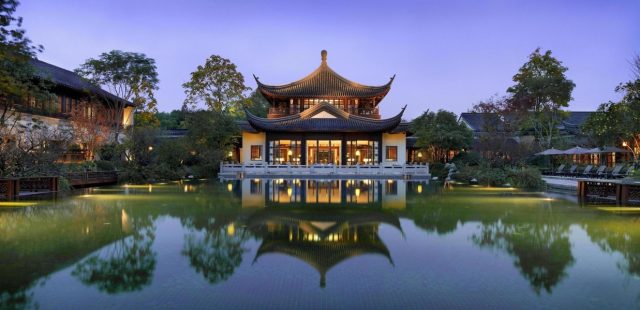
Designed by Japanese architect, Koichi San, the main dining room of Jin Sha (‘Golden Sand’) is characterised by vintage red hues, harking to those of an Imperial palace from the Southern Song dynasty, of which Hangzhou, then believed to be the largest city in the world, was the capital. This is reached via a glazed walkway lined with silvery boulders and a waterfall evoking falling snow to one aspect, with much of Gao’s cellar displayed under a golden hue in cabinets on the other. Beyond the 68-cover restaurant, served by a glass-fronted kitchen, are eleven silk panel adorned private dining rooms, lavishly pandering to 96 prosperous guests.
Drinks
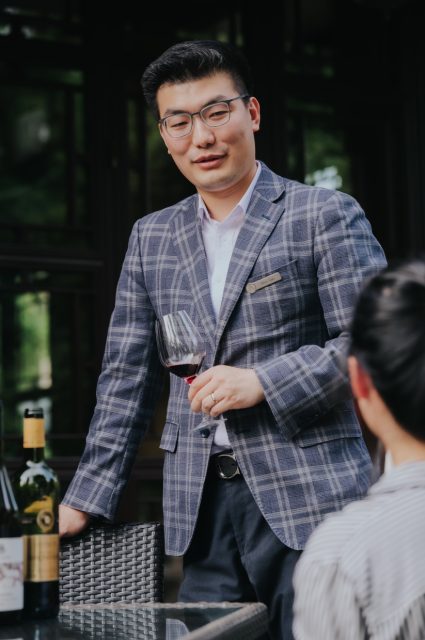
Commended by China Wine List Awards, the selection, running to 300 bottles, is overseen by head sommelier, Olive Gao, who has worked under the Four Seasons mantel since 2018, having earned his spurs at Hyatt. Options by the glass range from an Etna Bianco (Benati) to Tignanello, both drawn from 2020, with a sweeter pour being Cuvée Botrytis from Macon-Villages producer, Domaine de la Bongran.
By the bottle, Gao devotes an entire chapter to wines from Champagne, starring “the perfect fruit” of Egly-Ouriet, including three vintages of the still, red Ambonnay Coteaux Champenois. There is a clear fondness for Burgundy, too, hence the presence of big hitters from Coche-Dury, and Domaines, Leflaive and Roulot, while Petrus 1993 is but one statuesque Bordeaux.
Alongside Super Tuscans there is a carefully chosen range of Barolos and Barbarescos with age, including 2003 Ceretto, Bricco Asili amongst starrier names, and we noticed several bottles of Cervaro della Sala being conveyed deep into the private rooms along with ice buckets. From elsewhere in Europe, and ripe to pair with Jin Sha’s gently fragranced cuisine, are top Germans, including producers, Keller, and Egon Müller, who also crafts the also present Slovakian, Château Béla Riesling 2015, Juznoslovenski. Bold expressions from the USA, meanwhile, include Harlan, Opus One, and Au Sommet. Being one of Gao’s most fairly priced sections, Chinese bins include Jia Bei Lan Reserve 2016 from the trophied Helan Qingxue vineyard, Ningxia.
Dishes
Drawn from a silk effect menu echoing the region’s renowned silk trade, tonight’s spring-focused “dining experience” was guided by executive chef, Wang Yong, who scooped Forbes Top 30 Chefs in China, while retaining a four-star compliment from Forbes Travel Guide for eight consecutive years – the only venue in Hangzhou to be rewarded this way. He previously worked at the 1930s-style Whampoa Club on the bund of his native Shanghai.
Overseen by affable general manager of 10 years standing, Harbor Xu, dinner opened with a duo of vintages from an eponymous one-man-band producer in Yantai’s Qiushan Valley. Representing Yu’s third vintage, Jiang Yu Oak Ferment 2021 was buttery, bearing quality oak to the fore, saved by a lime-like acidity, while 2022 had a gentler touch. Intriguingly, the producer also nurtures a Grechetto. Gao extracted these using an “ESOMME” device which he said was designed in Guangzhou, its needle “coarser” than that of Coravin which he reserves for “more expensive” bottles. The pair paired well with the sea urchin roe, which provided agile seasoning to a soft-boiled, free-range chicken egg, mashed, earthy broad beans, and a frond of deep-fried toon, being an angular leaf best picked at the same time as the first flush of tea to prevent it accruing a punishing bitterness.
Partner Content
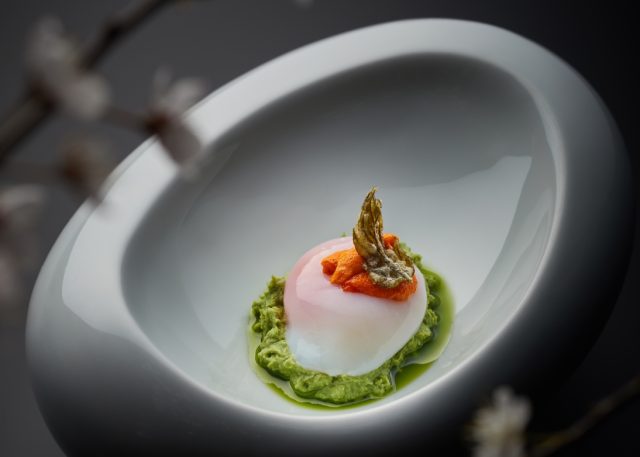
Next, deeply enriched by its freshwater cod stock, an Atlantic cod soup prettily combined impactful, aromatic yellow chive, glossy black fungus cups, dried bean curd, carrot, cucumber, ginger, and vermicelli. Xu advised adding a little dark vinegar to bring acidity.
Modestly described as “crispy chicken,” technically impressive, tasty, Peking-style chicken, wore super thin, ruddy, glossy, textured skin on gushingly luscious flesh, served with attractively crimped yam crisps. Having encountered many a goose on the boisterous streets of humid Hangzhou in preceding days, this lighter version came as a pleasant surprise.
Enriched with rock sugar, Wang Yong’s signature braised pork belly, a version of which he enjoys cooking for his family, nudged a similarly juicy abalone fished from a bank of illuminated tanks, and remarkably delicious hand-picked sweet peas – pellets from heaven. Alongside, Gao chose not wine, but one of the venue’s Chinese-accented cocktails. Muscular, the “Tungpo Theory” is made from both whisky and local Huangjiu rice wine which has been “fat washed” using pork lard from. Served in a terracotta vessel over hand-hewn ice embossed with the kanji for Yin Sha, the long-lived, cocoa-scented cocktail certainly scythed through the decadent dish.
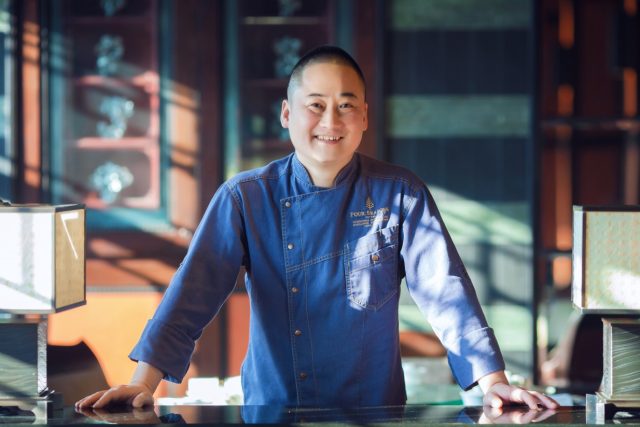
Returning to grape wine, Gao chose cult Aveyron red, Mauvais Temps 2019, for the next dish in which guests are encouraged to proudly fill snooker ball-sized deep-fried sesame balls with wok-fried spring chives, pork, and dried, grated bamboo shoots – the resort being set amidst glades of bamboo. Reaching just 11.5%, the goji and cranberry scented pour results from old oak matured Fer Servadou, Negret, and Cabernet Franc grown in a cliff-facing landscape infamous for its trying weather. Subject to partial carbonic maceration, and benefitting from dilating time in the glass to best suit the joyous dish, it was crafted by Nicolas Carmarans, who ran the famous, all-natural Paris wine bar, Café de la Nouvelle Mairie. Interestingly in terms of psychology, Gao mentioned he increased the price of what is one of his favourite bottles in an attempt to encourage guests to choose it.
The next pairing placed rice in the glass with rice on the plate. A trio of local Shaoxing Huangjiu rice wines met both a succulent shrimp wrapped around spring bamboo stems dusted in umami-enhancing bottarga, and an outstanding fried rice – the restaurant, and area, being famed for the sheer varieties of this dish. The latter was composed of puréed black truffle, egg whites, young minced beef, and tender spring onions. “We have many fried rice dishes – one for your every visit,” said Xu. Keen to underline the artisanal nature, and natural colour of his choice of Huangjiu, Gao shared images of his visits to meet its various distillers, one of which ascended from the role of tank washer to master distiller. Having been sealed with lotus leaves, then mud, clay jars, stacked four high, are initially aged outdoors, then within a hollowed mountain. Served in Riedel Burgundy glasses, 2007 Dong Qu had a staggering, sauce-like character, evoking a layered, bone dry Madeira replete with a satisfyingly indefatigable finish, while, from an imposing litre jar made of Longquan celadon, the more economically-priced, multi-vintage Pagoda ‘Ben’ Mei had a much smoother personality – evoking an upmarket take on a Twix bar. Finally, Kuai Ji Mountain 30 Years, was the most supple, though still brimming with a memorably agricultural personality.
Finally, deeply scented with the local, eminent Longjing green tea, which is ironically not as easy to find in Hangzhou’s restaurants as might be expected, and deliberately lighter than the traditional, sugary version of the West, crème brûlée had the engaging texture of a foie gras mousse.
Last word
Served by a long-standing team who are clearly experts in the culture of their restaurant, Gao’s choice of wines tonight, grape, and rice, drawn from smaller, meaningful producers, led to a memorable dining experience alongside the subtle, balanced dishes of Wang Yong.
Best for
- Prestige wines from France, Italy, and USA
- Huangjiu
- Unparallelled private dining rooms and peaceful setting
Jin Sha of Four Seasons Hotel Hangzhou at West Lake – 5 Lingyin Rd, Xihu, Hangzhou, Zhejiang, China, 310013; +86 571 8829 8888; fourseasons.com/zh/hangzhou/dining/restaurants/jin_sha
Earlier in his visit, Blyde paid a visit to Flair at The Ritz-Carlton, Xi’an.
Related news
Former Rémy Cointreau exec joins Nimbility in Japan
Trump hikes China tariffs to 125% but lowers tax for rest of world




